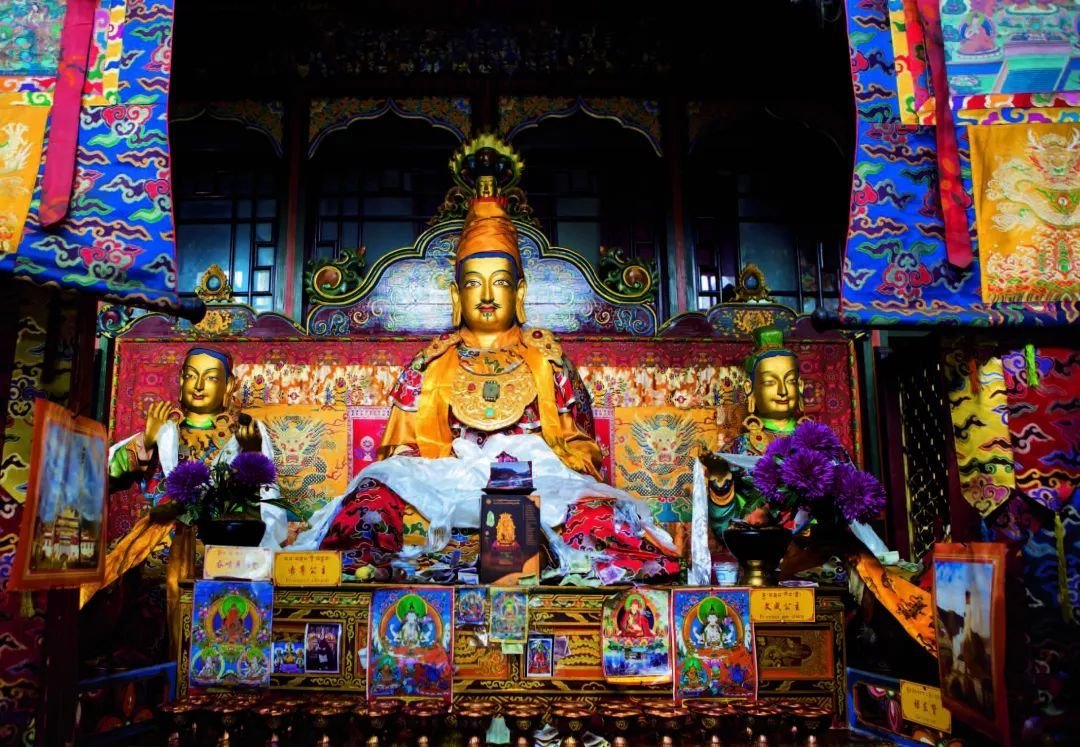The history of Buddhism in Tibet is a captivating tale of cultural exchange, adaptation, and innovation. From the initial introduction to the rise of powerful figures and the dominance of Tantrism, Tibetan Buddhism has carved its own unique path within the broader Buddhist tradition. It continues to be a vibrant and dynamic religion, practiced by millions worldwide.
Before the arrival of Buddhism in Tibet, the Tibetan people followed the Bon religion, a form of Shamanism brought from the Shang-shung kingdom in Ngari Prefecture. During the reign of King Lha Thothori Nyantsen, Indian missionaries brought sacred Buddhist scriptures to his court. These scriptures were kept secret and referred to as Nyanpo Sangwang, symbolizing the spread of Buddhism in Tibet.
The Unfolding Lotus: A Journey of Buddhism in Tibet
Tibetan Buddhism, a vibrant tapestry woven with rich history and unique practices, boasts a fascinating journey. Let’s delve into its evolution, from the roots of the indigenous Bon religion to its ultimate rise as the state religion of Tibet.
Origins and Emergence
Long before the arrival of Buddhism in Tibet, the ancient religion of Bon flourished. Bon is believed to have emerged around 1800 BCE, predating the introduction of Buddhism by many centuries. This indigenous spiritual tradition is rooted in the pre-Buddhist cultural and religious landscape of the Tibetan plateau.
Core Beliefs and Practices
Bon is characterized by a rich tapestry of beliefs and practices that include shamanism, animism, and a profound reverence for nature spirits. Central to Bon’s worldview is the belief in the interconnectedness of all life and the presence of spiritual entities in the natural world.
Shamanism
Shamanistic practices in Bon involve rituals conducted by shamans, who act as intermediaries between the human and spirit worlds. These shamans perform healing rituals, divination, and other ceremonies to maintain harmony and balance within the community and the natural world.
Animism
Bon’s animistic beliefs hold that all elements of nature, such as mountains, rivers, and trees, are inhabited by spirits. These spirits are revered and propitiated through various rituals to ensure their favor and protection.
Nature Reverence
The reverence for nature in Bon is deeply ingrained, with many rituals aimed at honoring and appeasing the deities associated with natural features. Sacred sites, such as lakes and mountains, are often considered abodes of powerful deities and are treated with utmost respect.
Mythology and Cosmology
Bon mythology is rich with creation stories, deities, and sacred texts. One of the central figures in Bon cosmology is Shenrab Miwo, the founder and spiritual leader of the Bon tradition. According to Bon mythology, Shenrab Miwo descended from a divine realm to teach and guide humanity, establishing the tenets of Bon.
Influence and Legacy
Despite the eventual dominance of Buddhism in Tibet, Bon has had a lasting influence on Tibetan culture and spirituality. Elements of Bon practices were incorporated into Tibetan Buddhism, leading to a unique syncretism that characterizes Tibetan religious life. Many Bon rituals, deities, and symbols can still be found in Tibetan Buddhist practices today.
The Seeds of Change: The Arrival of Buddhism (2nd Century CE)
Introduction of Buddhism
The arrival of Buddhism in Tibet around the 2nd century CE marked a significant turning point in the region’s spiritual and cultural history. This new spiritual tradition was introduced through trade routes and diplomatic missions that connected Tibet with India, a major center of Buddhist learning and practice at the time. The exchange of ideas and religious texts between these regions facilitated the gradual spread of Buddhist teachings into Tibetan society.
King Thothori Nyantsen’s Role
King Thothori Nyantsen, who reigned during this period, is credited with being open to these foreign influences and welcoming the initial Buddhist scriptures and teachings into Tibet. Under his leadership, the foundation was laid for Buddhism to take root and eventually flourish in Tibetan soil. This openness to new religious ideas set the stage for significant cultural and spiritual transformations in the centuries to come.
A Period of Coexistence (3rd-7th Centuries CE)
Peaceful Coexistence
The period between the 3rd and 7th centuries CE saw a relatively peaceful coexistence between the ancient Bon tradition and the newly introduced Buddhism. During this time, Buddhist missionaries and scholars began translating Buddhist scriptures into Tibetan, making these teachings more accessible to the local population. These translations played a crucial role in spreading Buddhist philosophy and practices throughout Tibet.
Gradual Acceptance
While Buddhism slowly gained popularity among certain segments of Tibetan society, Bon remained deeply entrenched in the region’s cultural and religious landscape. Bon practitioners continued their shamanistic, animistic, and nature-revering rituals, maintaining a strong presence in everyday life and spiritual practices.
Cultural Syncretism
This period of coexistence allowed for a unique cultural and religious syncretism to develop. Elements of Bon and Buddhism began to influence each other, leading to a distinctive Tibetan spiritual tradition that incorporated aspects of both religions. This blending of beliefs and practices created a rich and diverse religious tapestry that would come to characterize Tibetan spirituality.
Lasting Impact
The introduction and gradual acceptance of Buddhism set the stage for significant religious and cultural transformations in Tibet. While Bon continued to thrive, the influence of Buddhism grew steadily, eventually becoming the dominant spiritual tradition in the region. The peaceful coexistence of Bon and Buddhism during these centuries laid the groundwork for the complex and dynamic interplay between these two traditions that would continue to shape Tibetan culture and spirituality for centuries to come.
The arrival of Buddhism in Tibet in the 2nd century CE and the subsequent period of coexistence with the Bon tradition from the 3rd to the 7th centuries CE represent pivotal chapters in Tibetan history. This era of cultural and religious exchange not only enriched the spiritual landscape of Tibet but also set the stage for the profound transformations that would follow, leaving a lasting legacy on Tibetan society and its religious practices.
A Legacy of Rich Tapestry
In the 7th century, Emperor Songtsan Gampo sent scholar Thomi Sambota to study Indian script and language. He returned after six years, having mastered these skills and also translated Buddhist scriptures, including the lotus sutra. This marked the beginning of Buddhism in Tibet. Songtsan Gambo may have been influenced by his wives Trizun Brikuti from Nepal and Wencheng, and also for political and foreign relations reasons, he built numerous Buddhist temples.
The Rise of Powerful Figures: Padmasambhava and Shantarakshita (8th Century CE)
Padmasambhava
The 8th century CE marked a crucial period in the history of Tibetan Buddhism with the arrival of Padmasambhava, also known as Guru Rinpoche. This revered Indian tantric master is credited with significantly shaping Tibetan Buddhism. According to tradition, Padmasambhava was invited to Tibet by King Trisong Detsen to help overcome obstacles that were hindering the establishment of Buddhism in the region.
Contributions of Padmasambhava
- Subduing Local Deities: Padmasambhava is famed for his ability to subdue and convert local deities and spirits. By integrating certain Bon rituals into Buddhist practices, he made Buddhism more accessible and acceptable to the native Tibetan population.
- Incorporation of Bon Elements: This syncretic approach helped Buddhism to gain wider acceptance among the Bon followers, easing the religious transition and reducing resistance to the new spiritual paradigm.
Shantarakshita
Alongside Padmasambhava, Shantarakshita, a renowned Indian scholar, played a pivotal role in the establishment of Buddhism in Tibet. Invited by King Trisong Detsen, Shantarakshita laid the scholarly and institutional foundations for Tibetan Buddhism.
Contributions of Shantarakshita
- Founding Samye Monastery: Shantarakshita established the first Buddhist monastery in Tibet, Samye, around 787 CE. This monastery became a center for Buddhist learning and practice.
- Monastic Order and Scholarly Tradition: He promoted a scholarly approach to Buddhism, emphasizing the importance of philosophical study and debate. Shantarakshita’s efforts led to the development of a structured monastic order in Tibet.
The Dominance of Tantrism and the Establishment of State Religion (8th-14th Centuries CE)
Emergence of Tantric Buddhism
Following the foundational efforts of Padmasambhava and Shantarakshita, Tantric Buddhism, also known as Vajrayana, emerged as the dominant form of Tibetan Buddhism. This mystical and esoteric school emphasized rituals, mantras, and visualizations to achieve spiritual enlightenment.
Patronage and the Spread of Buddhism
The support of powerful Tibetan kings, particularly King Trisong Detsen, was instrumental in solidifying the position of Tantric Buddhism in Tibet. Royal patronage facilitated the construction of monasteries, the translation of scriptures, and the establishment of Buddhist institutions.
Development of Major Lineages
During this period, several influential lineages emerged, each contributing to the richness and diversity of Tibetan Buddhism.
- Nyingma: The “Ancient School,” considered the oldest of the four major schools, traces its origins to Padmasambhava.
- Kagyu: Known for its emphasis on meditation and the practice of Mahamudra, it was founded by Marpa and Milarepa.
- Sakya: Renowned for its scholarly contributions and the Lamdre (“Path and its Fruit”) teachings, it was founded by Khön Könchok Gyalpo.
Rise of the Gelugpa School
By the 14th century, the Gelugpa school, founded by Je Tsongkhapa, rose to prominence. Known for its rigorous monastic discipline and emphasis on scholarship, the Gelugpa school established a significant presence in Tibetan religious life.

Establishment of the Dalai Lama
The Gelugpa lineage’s leader, the Dalai Lama, emerged as the spiritual and temporal head of Tibet. This development further solidified Buddhism’s position as the state religion, intertwining the spiritual and political spheres of Tibetan society.
Tibetan Buddhism: Foundations and Practices
Philosophical Foundations: Mādhyamika and Yogācāra
Tibetan Buddhism is rooted in two main philosophical schools: Mādhyamika and Yogācāra.
Mādhyamika
- Founded by Nāgārjuna: The Mādhyamika, or “Middle Way,” school emphasizes the concept of śūnyatā (emptiness). It teaches that all phenomena are empty of inherent existence, aiming to transcend the extremes of eternalism and nihilism.
- Philosophical Approach: Mādhyamika employs rigorous logical analysis and dialectical reasoning to deconstruct all views and conceptual proliferations, leading to the realization of the true nature of reality.
Yogācāra
- Founded by Asaṅga and Vasubandhu: Also known as the “Mind-Only” school, Yogācāra focuses on the nature of consciousness and the processes by which perceptions and experiences arise.
- Key Concepts: Central to Yogācāra are the ideas of vijñaptimātratā (consciousness-only) and the eight consciousnesses, which include the alaya-vijñāna (storehouse consciousness) that holds the seeds of karmic imprints.
General Methods of Practice
Tibetan Buddhism employs a variety of practices aimed at achieving enlightenment. These methods can be broadly categorized into transmission and realization, analytic and fixation meditation, devotion to a guru, scepticism, preliminary practices, and the approach to Vajrayāna and esotericism.
Transmission and Realization
- Transmission: This involves receiving teachings and empowerments from a qualified master. The transmission of teachings ensures that the knowledge and blessings of the lineage are passed down unbroken.
- Realization: Practitioners internalize and realize these teachings through meditation and contemplation, leading to direct experiential understanding.
Analytic and Fixation Meditation
- Analytic Meditation (Vipassanā): This form of meditation involves investigating the nature of reality and the mind through logical analysis and contemplation. It is aimed at developing wisdom and insight.
- Fixation Meditation (Śamatha): This form of meditation focuses on calming the mind and developing concentration. Practitioners focus on a single object, such as the breath or a visualized deity, to stabilize the mind.
Devotion to a Guru
- Guru Yoga: Devotion to a spiritual teacher (guru) is a central practice. Guru yoga involves seeing the guru as an embodiment of the Buddha and receiving their blessings and guidance. This practice fosters a deep connection and trust between the student and the teacher.
Scepticism
- Critical Inquiry: Tibetan Buddhism encourages healthy scepticism and critical inquiry. Practitioners are urged to examine teachings thoroughly and not accept them blindly. This approach helps in developing a deep and authentic understanding of the Dharma.
Preliminary Practices (Ngöndro)
- Foundation Practices: Preliminary practices, or ngöndro, are essential preparatory practices that purify the mind and accumulate merit. They include practices such as prostrations, recitation of mantras, mandala offerings, and guru yoga.
- Purpose: These practices serve to prepare the practitioner for more advanced Vajrayāna practices by cultivating devotion, purification, and merit.
Approach to Vajrayāna and Esotericism
- Vajrayāna Buddhism: Also known as Tantric Buddhism, Vajrayāna is characterized by esoteric practices that involve the use of rituals, mantras, mudras, and visualizations. These practices are aimed at transforming the practitioner’s ordinary perception into a realization of enlightened wisdom.
- Empowerments and Secret Practices: Vajrayāna requires initiation and empowerment from a qualified master. These empowerments grant the practitioner access to specific tantric practices and protect them from potential misunderstandings and misuse of the teachings.
- Deity Yoga: A core practice in Vajrayāna involves the visualization of oneself as a deity and the recitation of associated mantras. This practice helps in realizing the inseparability of oneself and the enlightened state of the deity.
Tibetan Buddhism, grounded in the profound philosophical doctrines of Mādhyamika and Yogācāra, offers a rich and diverse array of practices aimed at achieving enlightenment. From the analytic and fixation meditation methods to the devotion to a guru and the esoteric practices of Vajrayāna, Tibetan Buddhism provides a comprehensive path that integrates wisdom, compassion, and skillful means. These practices, deeply rooted in tradition and adapted to the unique cultural context of Tibet, continue to guide practitioners on their spiritual journey toward awakening.
Conclusion
The period from the 8th to the 14th centuries CE was a transformative era for Tibetan Buddhism. The contributions of Padmasambhava and Shantarakshita laid the groundwork for the establishment and flourishing of Buddhism in Tibet. The emergence of Tantric Buddhism and the patronage of powerful kings facilitated the rise of influential lineages and the establishment of Buddhism as the state religion, shaping the religious and cultural landscape of Tibet for centuries to come.















